| Blériot XXVII | |
|---|---|
 | |
| Role | Racer aircraft |
| National origin | France |
| Manufacturer | Recherches Aéronautique Louis Blériot |
| First flight | September 1911 |
| Number built | 1 |
The Bleriot XXVII was a middle-wing, single-seat racing aircraft designed by Louis Bleriot.

| Blériot XXVII | |
|---|---|
 | |
| Role | Racer aircraft |
| National origin | France |
| Manufacturer | Recherches Aéronautique Louis Blériot |
| First flight | September 1911 |
| Number built | 1 |
The Bleriot XXVII was a middle-wing, single-seat racing aircraft designed by Louis Bleriot.

Data from [1]
General characteristics
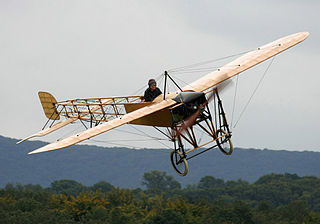
The Blériot XI is a French aircraft of the pioneer era of aviation. The first example was used by Louis Blériot to make the first flight across the English Channel in a heavier-than-air aircraft, on 25 July 1909. This is one of the most famous accomplishments of the pioneer era of aviation, and not only won Blériot a lasting place in history but also assured the future of his aircraft manufacturing business. The event caused a major reappraisal of the importance of aviation; the English newspaper The Daily Express led its story of the flight with the headline "Britain is no longer an Island".

The Blériot V was an early French aircraft built by Louis Blériot in 1907 and was his first monoplane. Although Blériot only achieved a couple of short flights in it, the second resulting in a crash which damaged the aircraft beyond repair, it was the first of his experimental aircraft to achieve any measure of success.

The Blériot-SPAD S.34 was a French twin-seat, single-engine biplane flight training aircraft designed in 1920. The side-by-side seating arrangement was unique for its time. 150 aircraft were built, 125 for the French Air Force, who used them until 1936.

The Blériot III was an early French aeroplane built by pioneer aviators Louis Blériot and Gabriel Voisin. It was later modified and renamed the Blériot IV, but both versions failed to fly.
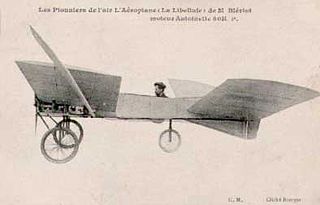
The Blériot VI "Libellule" ("Dragonfly"), was built in 1907 and was one of the series of experimental aircraft built by Louis Blériot which eventually led to the Blériot XI aircraft in which he made the first flight across the English Channel.
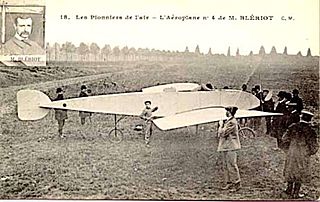
The Blériot VII was an early French aeroplane built by Louis Blériot. Following the success with the tandem wing configuration of the Blériot VI, he continued this line of development. The rear wing of his new design was about half the span of the forward wing, a step towards the configuration that would later be adopted as the basis for the vast majority of aircraft. The tail surfaces could be moved together, to act as elevators, or independently to act as ailerons: one of the first known examples of what would later become called elevons.

The Blériot VIII was a French pioneer era aeroplane built by Louis Blériot, significant for its adoption of both a configuration and a control system that were to set a standard for decades to come.
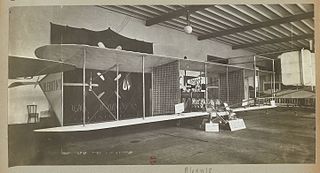
The Blériot X was an unfinished early French aeroplane by Louis Blériot. Its design was quite unlike anything else he had built and was modelled closely on the successful aircraft of the Wright brothers: a pusher biplane with elevators and rudders carried on outriggers. After exhibiting it at the Salon de l'Automobile et de l'Aéronautique in Paris in December 1908, Bleriot abandoned it and returned to developing his increasingly successful monoplane designs.

The Blériot 127 was a French bomber aircraft of the 1920s and 1930s, developed from the Blériot 117 escort fighter. It was a large monoplane of conventional configuration that featured open gunner's positions in its nose and at the rear of its two underwing engine nacelles. The wing airfoil was of sufficient thickness that these latter positions could be accessed from the fuselage in flight.

The Blériot-SPAD S.46 was a small French airliner of the 1920s, developed from the Blériot-SPAD S.33. Like its predecessor, it was a conventional biplane that seated four passengers in an enclosed cabin while the pilot and occasionally a fifth passenger rode in an open cockpit. The S.46 had a redesigned wing of longer span and a far more powerful engine. The type was employed by Franco-Roumaine, which purchased 38 out of the 40 examples produced for use on their continental European routes.

The Blériot 111 was a French four-seat executive transport monoplane designed by André Herbemont. The first French aircraft to be fitted with a retractable landing gear, after six years development it was not ordered into production.
The Airdrome Bleriot Model XI, also referred to as the Airdrome Bleriot XI, is an American amateur-built aircraft, designed and produced by Airdrome Aeroplanes, of Holden, Missouri. The aircraft is supplied as a kit for amateur construction.
The Blériot-SPAD S.29 was a sport aircraft produced in 1919 by Blériot-SPAD.
The Blériot 73 was a large First World War French heavy night bomber designed and built by Blériot to the BN3 specification. Only a single prototype was built, which crashed on landing from its first flight, killing the pilot. The Blériot 74, Blériot 75 and Blériot 76, respectively, a heavy bomber / airliner, airliner and heavy bomber, directly evolved mfrom the Blériot 71 / Blériot 73 bombers.
The Blériot XLII was a First World War French reconnaissance plane designed and built by Blériot.
The Blériot XLIII was a First World War French reconnaissance plane designed and built by Blériot.
The Bleriot XXV was a high wing observation monoplane designed by Louis Bleriot. Only one aircraft was built, and it had a single seat for observational purposes.
The Blériot XXXIII Canard Bleu was a middle-wing, two-seat tourism aircraft designed by Louis Bleriot. It had a canard configuration.
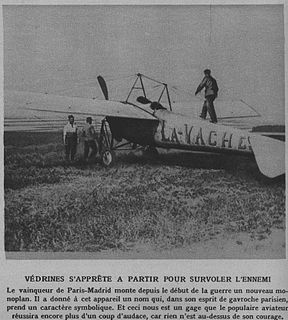
The Blériot XXXVI Torpille was an observation monoplane designed in France by Louis Bleriot during the early 1910s. The Blériot XXXVIbisLa Vache was operated by Jules Védrines on several daring missions behind enemy lines in the early months of the war.
The Bleriot XL was a two-seat observation sesquiplane designed in France by Louis Bleriot during the early 1910s. Its structure was made of metallic materials.
| Wikimedia Commons has media related to Blériot XXVII . |